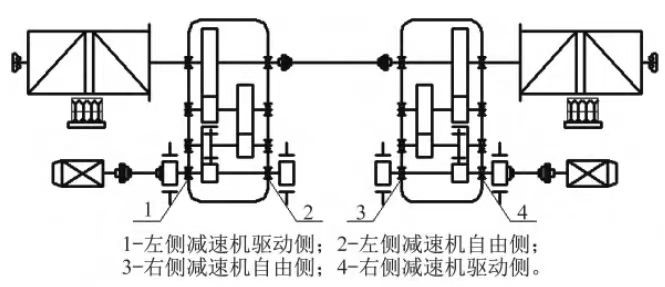There are many fault diagnosis techniques for gearbox bearings, among which vibration diagnosis technology is the most widely used and has a significant effect. By tracking and detecting abnormal vibration information of the reducer of the main lifting mechanism of the crane, using time-domain analysis, frequency-domain analysis, envelope demodulation analysis, and comparing and analyzing with similar equipment under the same working conditions, as well as using technical means such as listening stick inspection during bearing operation, the fault is gradually confirmed. Elaborate on the discovery of vibration anomalies, analysis of vibration anomalies, tracking of degradation trends, as well as the process of identifying and handling faulty parts.
Gearbox vibration diagnosis is a technology that determines the operating status and performance of a gearbox by monitoring and analyzing its vibration signals. By diagnosing the vibration of the gearbox, faults and problems can be detected in a timely manner, and maintenance and repair can be carried out in advance to avoid production downtime and losses caused by faults.
The application of gearbox vibration diagnosis includes the following aspects:
1. Fault diagnosis: By monitoring the vibration signal of the gearbox, it can be determined whether there is a fault in the gearbox, such as bearing wear, gear damage, imbalance, and other issues.
2. Preventive maintenance: By regularly monitoring the vibration signals of the gearbox, potential signs of failure can be detected in a timely manner, and maintenance and upkeep can be carried out in advance to extend the service life of the gearbox.
3. Performance evaluation: By analyzing the vibration signals of the gearbox, the operating status and performance of the gearbox can be evaluated, providing a reference basis for optimizing equipment operation.
4. Fault analysis: By analyzing the vibration signal of the reducer, the specific cause and location of the fault can be determined, providing guidance for troubleshooting.
Overall, gearbox vibration diagnosis can help enterprises improve equipment reliability and stability, reduce faults and losses, and improve production efficiency and product quality.

It is very important to choose appropriate monitoring points when diagnosing gearbox vibration. Here are some common recommendations for selecting vibration monitoring points for gearboxes:
1.Bearing position: The bearing is one of the most prone components to failure in the gearbox, so setting vibration monitoring points at the bearing position is very important. Usually, the bearing positions at the input and output ends can be selected for monitoring.
2. Gear position: The gear is another important component in the gearbox, and its damage can lead to increased vibration. Therefore, it is also necessary to set up vibration monitoring points at the gear position.
3. Shell surface: Monitoring the vibration on the surface of the reducer shell can help determine the operating status of the entire reducer system, including whether there is any abnormal vibration or resonance phenomenon in the shell.
4. Motor position: The reducer is usually connected to the motor, so it is necessary to set vibration monitoring points at the motor position to help determine whether the connection between the motor and the reducer is normal.
5. Key component positions: In addition to the above positions, other key component positions can also be selected for vibration monitoring according to specific situations, in order to comprehensively understand the operating status of the reducer.
When selecting monitoring points, it is necessary to consider factors such as their representativeness, ease of installation and maintenance, and ability to cover critical components. At the same time, it is necessary to determine the most suitable monitoring point based on the specific type and usage of the gearbox. It is best to follow relevant installation specifications and requirements when installing vibration sensors to ensure the accuracy and reliability of monitoring data.
Senther sensor recommendation
1.Single axis industrial vibration sensor: Senther model: 310A Performance characteristics: sturdy and durable, corrosion-resistant packaging, metal welding sealing, shell isolation, EMI/RFI shielding, impact resistance protection
2. Three axis vibration acceleration sensor: Senther model: 334A Performance characteristics: three-axis measurement, 4-pin connector output, adhesive or screw installation, metal welding sealing, circular shear mode, broadband response
The above images are from the internet. If there is any infringement, please contact the administrator in a timely manner to delete them


